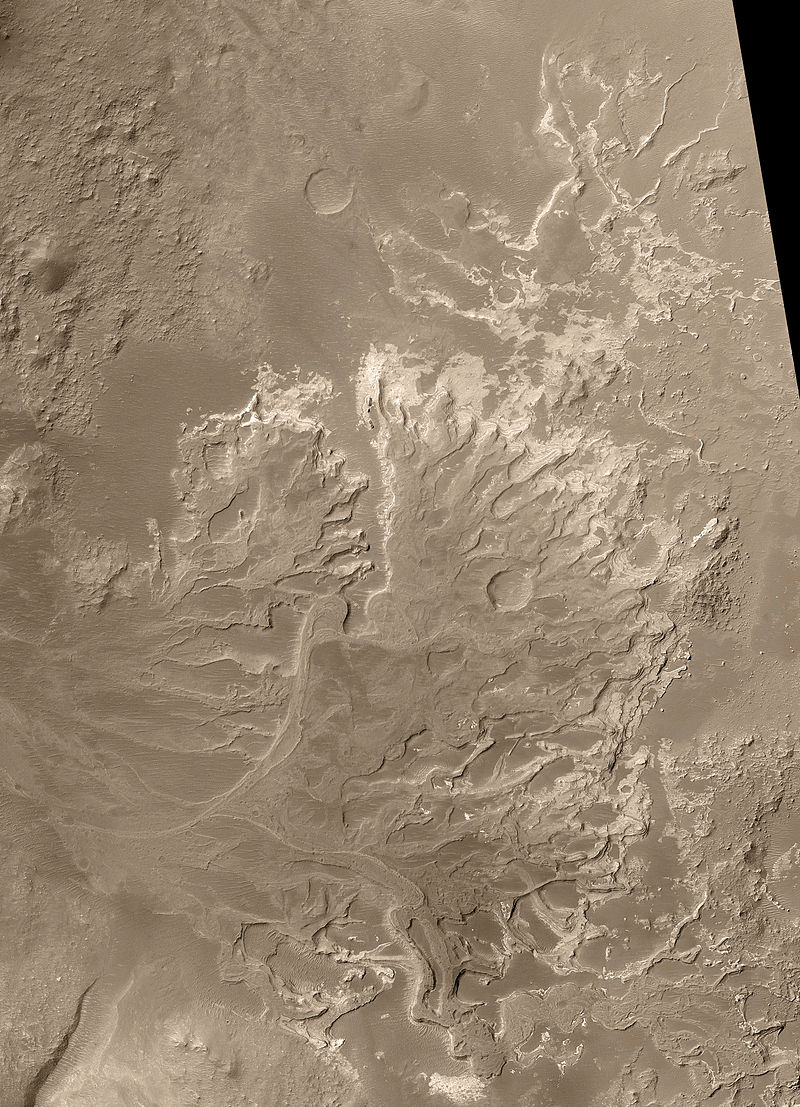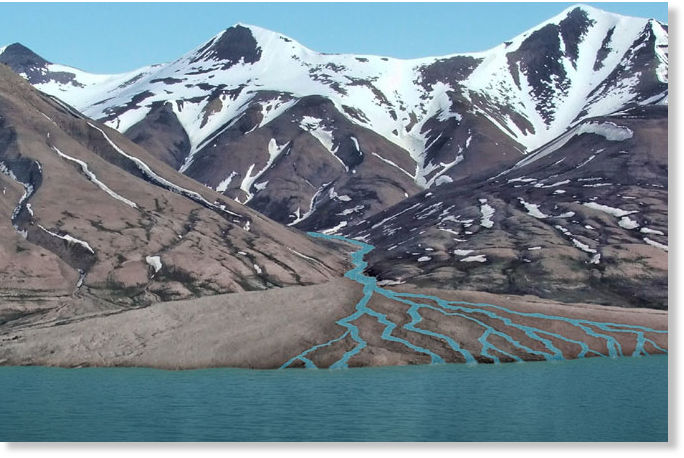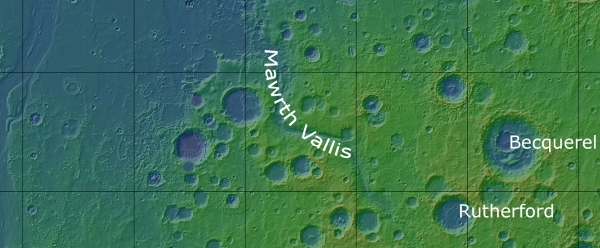

And if we were talking about water on mars ...
it will bring to and maintain the life of the new Martians.
When we talk about the subject of water on Mars, we must distinguish between water in the past and water nowadays. In the past, it is associated with life that found a favorable environment on Earth; nowadays, it is associated with the needs that the men who will go to the Red-planet will have to satisfy.
In the past, it is now indisputable that liquid water ran on Mars, in abundance. As on Earth, it was most likely lacking at the origin, as the planet was formed under the "ice line", beyond which the violent young Sun had repelled all the volatile elements of its protoplanetary disk. But the system in formation was by definition unstable and the "Great Tack" of Jupiter and Saturn (spiraling of Jupiter towards the Sun and then pulling backward together with Saturn) very likely brought a considerable amount of water from the outer part of the Asteroid Belt (the one that lies beyond the ice line) and also from the Kuiper Belt (beyond Neptune), as Saturn returning to its orbit of origin (actually a little further), rejected Neptune Beyond Uranus in this Belt made of objects rich in water ice (and perhaps much further away, "Planet 9" which could have been where Saturn is orbiting today itself...but this is another story !).
 Still, liquid water probably filled the Northern-Lowlands and large depressions in the Southern-Highlands (Hellas and Argyre basins, Eridania Sea, many craters). A water cycle existed, with evaporation under a thick primitive atmosphere and generating a powerful greenhouse effect by its very high carbon dioxide content. It rained and snowed and rivers flowed in the intertropical zone towards the lowest areas; waterlogged soil released cataclysmic flows on the occasion of the making of huge volcanic massifs, especially that of Tharsis which by its mass triggered gigantic faults (Valles Marineris). For a few hundred million years, in a warm soil environment due to the recent accretion of the planet, water hydrated the rocks and transformed them. It was at this time that life could have begun on Mars but nothing is sure. We can say that the "ingredients" were there but subtle differences in the environment may have "made the difference". Perhaps also, did Time not "left enough time to time". Indeed, already around 4 billion years ago, Martian atmosphere not retained by a too weak gravity and unprotected by a sufficiently powerful magnetosphere, had considerably dwindled (pressure similar to that of today). But the planet was young, the crust still thin and the volcanic emissions of gas and dust, important and frequent. The second Martian eon, the Hesperian, named Theiikian, the Age of Sulfur, by the astrophysicist Jean-Pierre Bibring, prolonged the conditions favorable to liquid water on the surface until about 3.5 billion years ago. Then volcanic episodes became more and more exceptional even though they were more and more violent (thickening of the planetary crust). To sum up, the planet turned into an arid desert at that time and recovered "habitable" conditions only intermittently with more and more delays between the active periods which were shorter and shorter. The nagging question that arises since the exploration of Mars began is therefore whether life could start before aridity generalized (life started on Earth between 4 and 3.7 billion years ago).
Still, liquid water probably filled the Northern-Lowlands and large depressions in the Southern-Highlands (Hellas and Argyre basins, Eridania Sea, many craters). A water cycle existed, with evaporation under a thick primitive atmosphere and generating a powerful greenhouse effect by its very high carbon dioxide content. It rained and snowed and rivers flowed in the intertropical zone towards the lowest areas; waterlogged soil released cataclysmic flows on the occasion of the making of huge volcanic massifs, especially that of Tharsis which by its mass triggered gigantic faults (Valles Marineris). For a few hundred million years, in a warm soil environment due to the recent accretion of the planet, water hydrated the rocks and transformed them. It was at this time that life could have begun on Mars but nothing is sure. We can say that the "ingredients" were there but subtle differences in the environment may have "made the difference". Perhaps also, did Time not "left enough time to time". Indeed, already around 4 billion years ago, Martian atmosphere not retained by a too weak gravity and unprotected by a sufficiently powerful magnetosphere, had considerably dwindled (pressure similar to that of today). But the planet was young, the crust still thin and the volcanic emissions of gas and dust, important and frequent. The second Martian eon, the Hesperian, named Theiikian, the Age of Sulfur, by the astrophysicist Jean-Pierre Bibring, prolonged the conditions favorable to liquid water on the surface until about 3.5 billion years ago. Then volcanic episodes became more and more exceptional even though they were more and more violent (thickening of the planetary crust). To sum up, the planet turned into an arid desert at that time and recovered "habitable" conditions only intermittently with more and more delays between the active periods which were shorter and shorter. The nagging question that arises since the exploration of Mars began is therefore whether life could start before aridity generalized (life started on Earth between 4 and 3.7 billion years ago).
If it started, it could have kept going in a very primitive way, in the underground, where the water was necessarily present since there is still now abundant water ice, under a thin layer of regolith, everywhere, even in the intertropical zone.
 In this context, we pass to present days and the possibility offered by the planet, because of this water, to provide for the needs of a human population. Bases will be built near water deposits. Martian water is somewhat "heavy" (high percentage of deuterium – twice that of Earth water - compared to hydrogen) because the lighter elements tend to be lost by sublimation in the atmosphere and the latter then in space, but water will remain consumable and usable for all kinds of needs (including producing methane from its hydrogen, using the Sabatier’s reaction). We must not imagine that Man could behave on Mars, as carefree from the point of view of his consumption as he has been on Earth. Mars is a fragile planet, more than Earth; its resources are quite limited. Faster than on Earth, we will not be able to do just anything we want. As a consequence, we will not be allowed by “Nature” to let our population explode, and it will be necessary, from the beginning of the human presence, to recycle everything as much as possible. We will be used to it because during the first inhabited missions, when equipment and chemicals will be by necessity very rare (it will be necessary to import from the Earth almost any transformed product and start as soon as possible producing them, with great difficulties), Man will have applied to himself and his actions the rule of “you shall not spoil”, anything. From this point of view Mars will be an ecological laboratory and the Martians an ecological example for the Earthlings.
In this context, we pass to present days and the possibility offered by the planet, because of this water, to provide for the needs of a human population. Bases will be built near water deposits. Martian water is somewhat "heavy" (high percentage of deuterium – twice that of Earth water - compared to hydrogen) because the lighter elements tend to be lost by sublimation in the atmosphere and the latter then in space, but water will remain consumable and usable for all kinds of needs (including producing methane from its hydrogen, using the Sabatier’s reaction). We must not imagine that Man could behave on Mars, as carefree from the point of view of his consumption as he has been on Earth. Mars is a fragile planet, more than Earth; its resources are quite limited. Faster than on Earth, we will not be able to do just anything we want. As a consequence, we will not be allowed by “Nature” to let our population explode, and it will be necessary, from the beginning of the human presence, to recycle everything as much as possible. We will be used to it because during the first inhabited missions, when equipment and chemicals will be by necessity very rare (it will be necessary to import from the Earth almost any transformed product and start as soon as possible producing them, with great difficulties), Man will have applied to himself and his actions the rule of “you shall not spoil”, anything. From this point of view Mars will be an ecological laboratory and the Martians an ecological example for the Earthlings.
An original use of water could be applied in building. We can easily make “duricrete” (very hard cement) simply by wetting the regolith, but above all, it is conceivable that habitable domes would be covered with ice blocks in plastic envelopes (to avoid sublimation when temperature rises above freezing). These layer of ice, wrapping the geodesic spheres made of (Martian) metal of our habitats, would present the advantage of exerting some counterpressure versus the pressure of inner breathable air, alleviating efforts on the structure and blocking solar radiations, rich in protons such as hydrogen’s water.
You see. We can do a lot of things with water and, by the force of necessity and scarcity, creativity will be continually stimulated on Mars.


